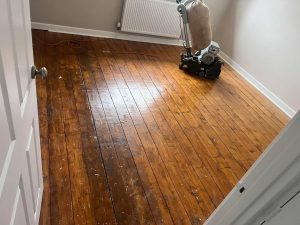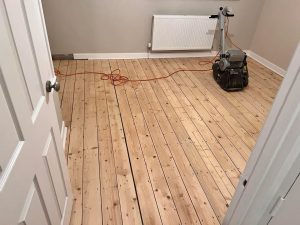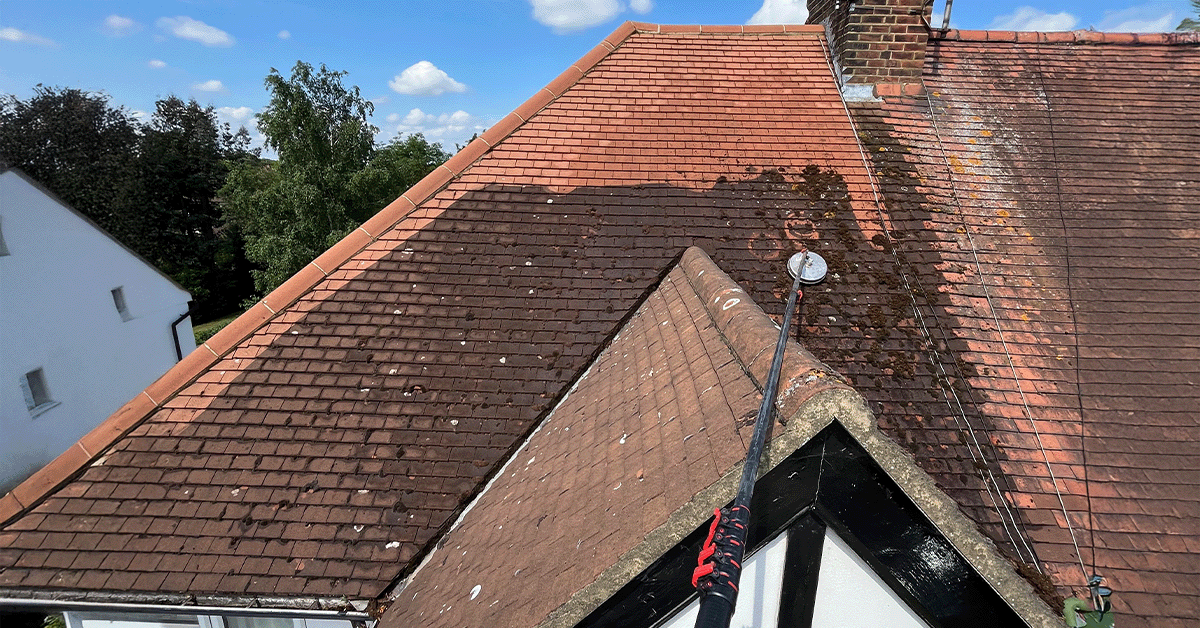Wooden floors are beautiful and add real value to your home or business. But knowing when to refinish hardwood floors can be tricky. Get it right, and your floors will look amazing for years. Get it wrong, and you might damage your investment.
At BaMaPa Clean, we help London homeowners and businesses keep their hardwood floors looking their best. We use pet-safe, child-friendly methods because your family’s safety comes first. Our high quality approach means you get results that last.
What is hardwood floor refinishing?
Floor refinishing means removing the old, worn protective layer and applying a fresh one. Think of it like giving your wooden floors a complete makeover. The process involves completely sanding away scratches, stains, and dullness, then applying new protective coatings.
This protective layer acts like a shield for your floors. When it wears down, your actual wood becomes vulnerable to water damage and permanent staining. That’s why timing matters so much.
How long do different types of flooring last?
Traditional hardwood floors can last 30 to 100 years when properly maintained. That’s incredible value when you think about it. The type of flooring affects how often you’ll need to sand and refinish.
Solid wood floors last longer than engineered options. Engineered floors typically give you 20 to 30 years of service. The difference comes down to construction – solid wood goes all the way through, whilst engineered has layers with a hardwood top.
Different wood types age differently too. Pine floors actually get harder over time, which is why 100-year-old pine floors still look great. Oak and cherry typically serve you well for about 30 years.
When should you refinish hardwood floors?
Most wooden floors need refinishing every 8 to 12 years. But this varies hugely based on your specific situation. Here’s what affects your timeline:
| Area Type | Refinishing Schedule |
|---|---|
| High-traffic areas (hallways, kitchens) | Every 3-5 years |
| Medium-traffic areas (living rooms) | Every 7-10 years |
| Low-traffic areas (bedrooms) | Every 10-15 years |
These timelines assume you clean the floor regularly and maintain it properly.
What affects how often your floor requires refinishing?
Traffic levels make the biggest difference
High-traffic areas take a real beating. Hallways, kitchens, and main living spaces need attention every 3 to 5 years because they see constant use.
Compare that to a spare bedroom that rarely gets used. These quiet spaces can often go 10 to 15 years between treatments because they don’t experience the same wear.
Wood type matters
Softer woods like pine show damage more easily. These typically need wood floor sanding every 5 to 7 years under normal conditions.
Harder woods like oak and maple resist damage better. They can usually go 7 to 10 years between refinishing because their dense structure handles daily life better.
Your maintenance routine
How you clean the floor makes a huge difference. Regular sweeping prevents dirt acting like sandpaper. Using rugs in busy areas protects the wood underneath. Furniture pads prevent scratches when you move things around.
Homes with excellent maintenance often double the time between refinishing. Properties that get neglected need attention much sooner.
Clear signs you need to refinish hardwood
Damage you can see
Excessive scratches are usually the first warning sign. We’re not talking about tiny marks from normal use – but when scratches catch your fingernail or affect the overall look, it’s time to act.
Water stains show that moisture has broken through your protective layer. Dark spots or rings from glasses mean the finish is failing. Left untreated, this leads to warped boards and expensive repairs.
Fading from sunlight is normal to some extent, but extreme or uneven colour changes suggest the protective coating is breaking down.
Changes you can feel
Run your hand across your floor. It should feel smooth and consistent. Rough patches mean the protective layer is wearing away.
Dull areas that won’t shine up with regular cleaning are another clear sign. If cleaning doesn’t restore the lustre, the finish is worn through to the wood.
The water test
Here’s a simple check: put a few drops of water on your floor in different spots. On properly sealed floors, water should bead up and stay on the surface. If it soaks in quickly, your protective coating needs attention.
Different finish types and schedules
The type of finish affects how often you’ll need floor restoration. Water based polyurethane finishes offer excellent durability and work particularly well for busy areas. They cost more initially but typically last longer.
Oil-based polyurethane provides similar durability with a warmer appearance. Both polyurethane finishes generally last longer than traditional wax options.
Wax finishes look beautiful and bring out natural wood colours, but they need more frequent maintenance than polyurethane alternatives.


Why hiring a professional matters
To refinish hardwood properly requires specialised equipment and expertise. Professional sanders, dust collection systems, and finish application tools aren’t available to most homeowners. More importantly, mistakes can permanently damage your floors.
Our experienced team at BaMaPa Clean knows how to assess each situation and recommend the right approach. We understand which woods need gentle handling and which can handle more aggressive restoration. Our hardwood strip floor restoration service uses proven techniques to restore your floors safely.
Professional work also ensures proper safety. The process involves chemicals and equipment that need proper handling. We take care of all safety requirements whilst delivering results that last.
The refinishing process explained
Assessment and preparation
First, we assess your floor’s condition to determine the best approach. Some floors only need light sanding and recoating, whilst others require completely sanding back to bare wood.
We protect your furniture and belongings, then prepare the area for dust-free sanding.
Sand the floor
We start with coarse grits to remove the old finish and major imperfections, then progress to finer grits for a smooth surface. Modern dust collection systems keep your home clean during this process.
Apply the stain (if needed)
If you want to change or refresh the colour, we apply the stain after sanding. This step requires expertise to achieve even coverage and the right colour depth.
Apply the finish
The final protective coating goes on in multiple thin layers. Each coat needs several hours to dry before the next application. Research from the Journal of Wood Science shows that water based finishes dry faster than oil-based options but both provide excellent protection when applied correctly.
Costs and planning
Floor refinishing costs much less than replacing your entire floor. A quality refinishing job can make 20-year-old floors look brand new.
Planning ahead helps spread costs over time. If you know busy areas need attention every 5 years, you can budget accordingly. Many homeowners refinish sections at different times rather than doing everything at once.
Regular maintenance between refinishing extends your timeline significantly, saving money long-term.
Making your floors last longer
Daily care
Sweep or vacuum regularly to remove dirt that can scratch floors. Use appropriate hardwood cleaners – never plain water or harsh chemicals that damage the finish.
Put mats at entrances to catch dirt before it reaches your floors. In busy areas, use attractive rugs that protect the wood whilst complementing your décor.
Furniture protection
Use felt pads under all furniture legs. When moving furniture, always lift rather than drag. Even small movements can cause scratches that build up over time.
Climate control
Keep humidity levels consistent. Wood expands and contracts with humidity changes, which can stress the finish. Aim for 30-50% humidity year-round.
Use curtains or blinds to reduce direct sunlight. UV rays fade and damage finishes over time, especially in south-facing rooms.
When to call professionals
Some situations need professional assessment rather than waiting for obvious damage. If your floors are approaching typical refinishing timelines, have them evaluated even if they still look decent.
Water damage needs immediate professional attention. Even small leaks can cause problems that aren’t immediately visible. Quick action often prevents major damage.
If you’re selling your property, professional assessment helps determine whether refinishing provides good return on investment.
Frequently asked questions
How long does hardwood floor refinishing take?
Most residential projects take 3-5 days from start to finish. This includes sanding, applying multiple finish coats, and drying time. You’ll need to stay off the floors for 24-48 hours after the final coat. Our team provides specific timelines based on your project and the products we use.
Can engineered hardwood be refinished?
Yes, but with limits. Engineered floors have a thinner wear layer on top, so they can typically only be refinished 1-3 times during their lifespan. Solid wood can be refinished many more times. We assess your specific flooring to determine if refinishing is possible.
Will refinishing remove all damage?
Most surface scratches and many stains can be completely removed through proper refinishing. Very deep scratches that go into the wood itself might leave some traces. During assessment, we’ll honestly discuss what results you can expect.
Is the process safe for families?
When done professionally with proper precautions, absolutely. We use low-VOC, environmentally friendly products and ensure proper ventilation. We’ll discuss timing to minimise disruption and provide clear guidance on when it’s safe to return. Your family’s safety is our priority.
The bottom line
Knowing when to refinish hardwood floors protects your investment and keeps your home looking beautiful. Whilst general guidelines suggest every 8-12 years, your specific situation might need different timing.
Watch your floors’ condition rather than just following a calendar. High-traffic areas, water damage, or extensive scratching might mean earlier refinishing. Well-maintained quiet areas can often wait longer.
Professional assessment takes the guesswork out of timing decisions. Our experienced team can evaluate your floors and recommend the best approach. We’re committed to using safe, effective methods that protect your family whilst delivering outstanding results.
Timely refinishing costs much less than floor replacement and adds years to your wooden floors’ lifespan. With proper care and professional attention when needed, your floors can stay beautiful for generations.
Ready to discuss your needs? Contact BaMaPa Clean today for professional assessment and personalised recommendations for your London home or business.

